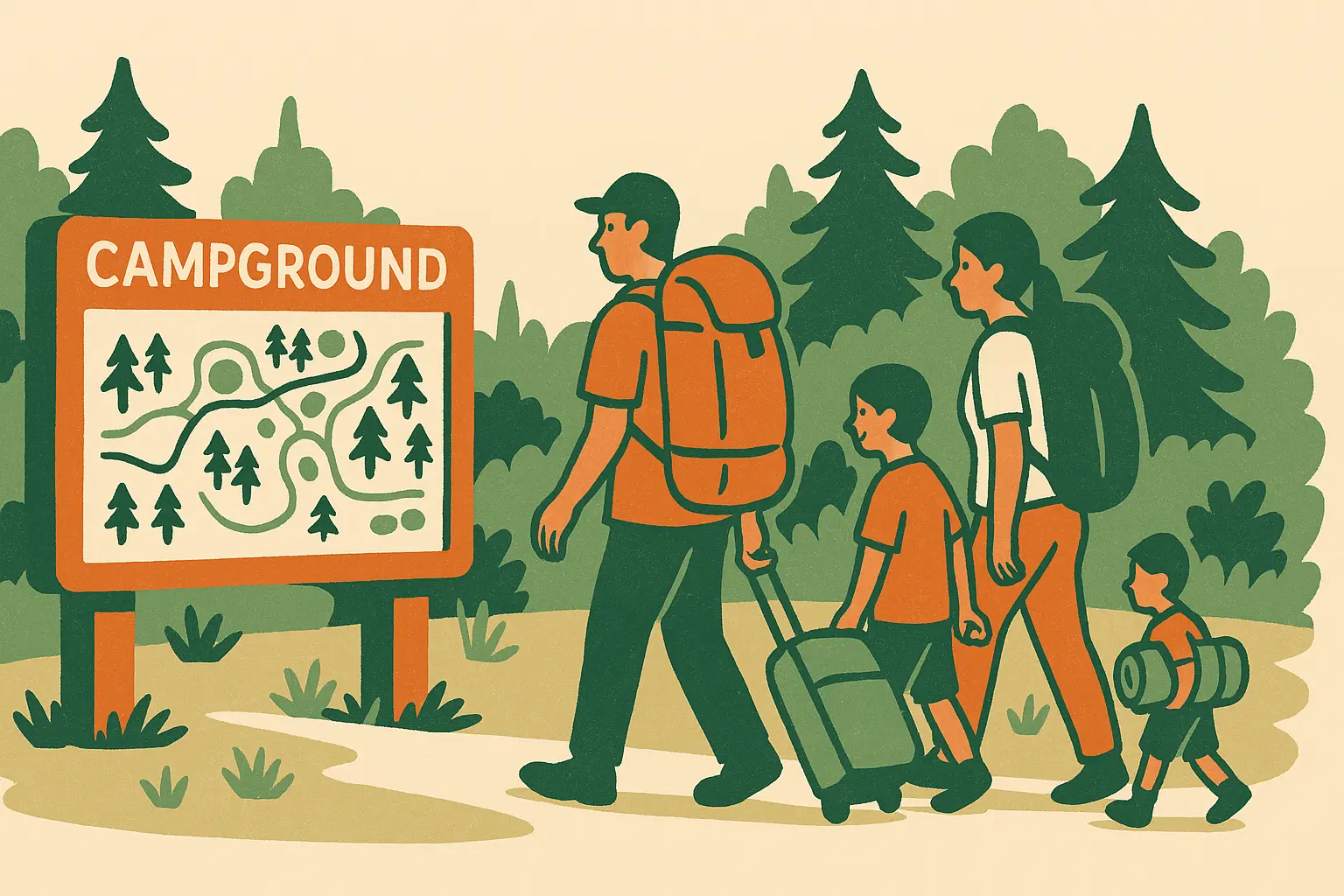How to Choose the Best Campsite for Your Family
I still vividly remember one of our first family camping trips like it was yesterday. Mostly because we had to chalk it up as a major disaster. We had reserved the perfect spot. It has a “scenic lake view” and “family-friendly amenities.”
What we got was a bumpy and sloped tent pad. The lake view was a sliver of lake visible through a thick patch of trees. The closest bathroom was a 5 minute hike through mosquito-infested woods.
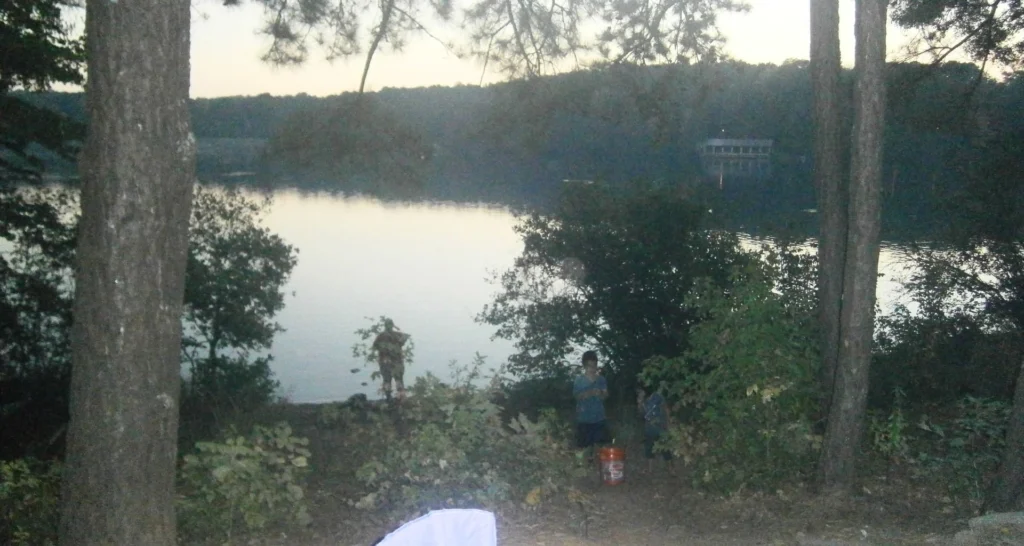
My then four-year-old had a meltdown every time nature called. We cut our trip short and headed back home the next morning. And this is why I say your first camping trip needs to be close to home.
That one trip taught me something critical. The campsite you choose can make or break your entire trip.
Pick the wrong spot, and instead of relaxing around a fire you’ll spend your entire trip dealing with preventable problems.
Choose wisely, and you’ll create the kind of magical memories that last your family a lifetime.
The good news?
You don’t need decades of camping experience to pick a great site. You just need to know what to look for.
This is why we are writing this guide for you. We will walk you through everything you need to know, from choosing the right type of campground to how to actually book your site.
What Kind of Campground Is Best for Families?
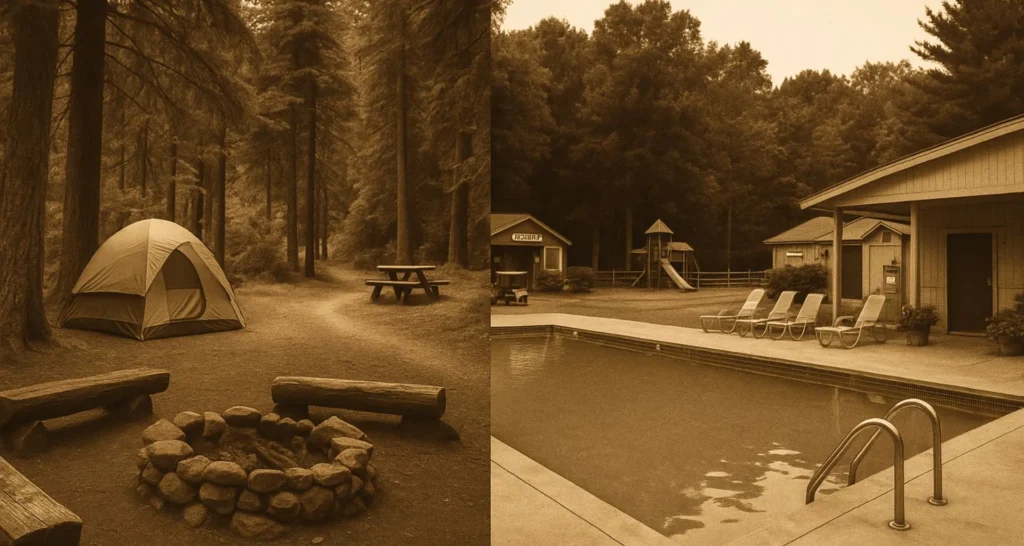
Before you start picking your perfect campsite, you have to find a campground. This is very important when you’re camping with kids.
The campground you choose matters just as much as, if not more than the individual site. Some are designed for people who want to rough it while others feel like summer camp with Wi-Fi.
There are two main types of campgrounds.
- Public Campgrounds – These include state and national parks. They’re affordable, beautiful, and full of hiking trails and nature. However, they may not have amenities like showers or flush toilets.
- Private Campgrounds – These are places like KOA or Jellystone. They offer pools, organized activities, hot showers, and even camp stores. They’re built for convenience and comfort. The tradeoff is these cost more and feel less rustic.
For your first family camping trip, I strongly recommend you pick a private or well-developed public campgrounds.
They will reduce how much stress you have. This makes it easier to enjoy camping while you figure out what you are doing.
Tip: Look for keywords like “family-friendly” or “kid-approved” in reviews. Also pay attention to information about the noise level, state of the bathrooms, and available kid activities.
How Far from Home Should You Camp?
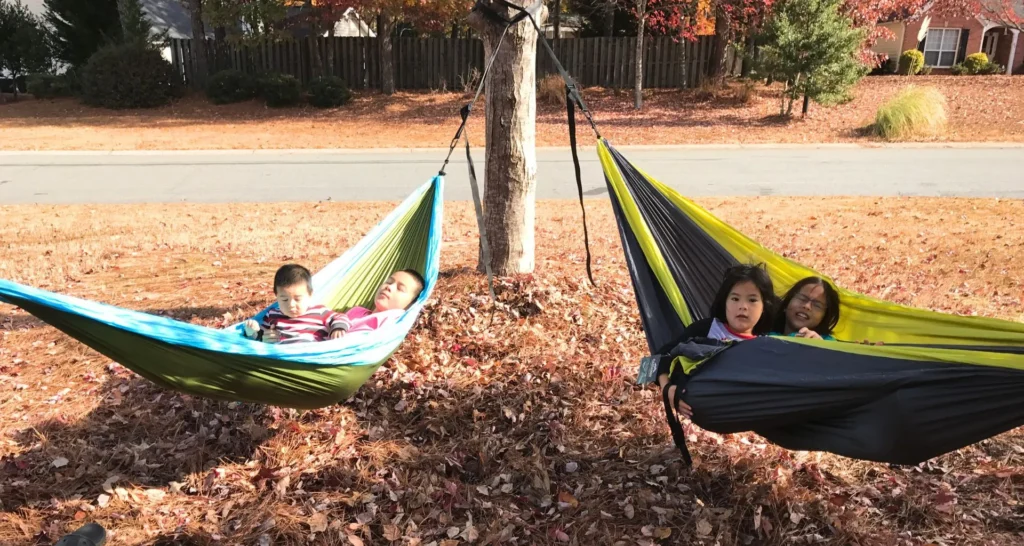
As tempted as you might be to pack up and drive 16 hours to Yellowstone, don’t do it. We highly recommend you stay within a 1–2 hour drive of your house.
Why?
The less experience you have, the more chance of things going awry.
- If someone gets sick, you can make it back home quickly.
- Forgot something essential? You can run back home and get it.
- Less time driving means more time having fun. And as anyone with kids knows, less time in the car means less whining.
- You’ll feel way more confident if things don’t go perfectly knowing home is a short drive away.
Our first “successful” trip happened because we could bail if needed. We didn’t have to. However, knowing we could get back home quickly, made us all feel more confident. Knowing is half the battle.
Tip: Local doesn’t have to mean boring. Look around and you will most likely be amazed at how many great campgrounds are literally in your backyard. Even if they don’t have breathtaking scenery, give one of them a shot for your first trip. Kids don’t need epic views. They need logs to climb, dirt to play in, and a campfire to dance around.
What Makes a Great Family Campsite?
Once, I picked a campsite right next to the bathrooms. Was it convenient? Sure was. Until we were kept awake all night by slamming doors, people walking and talking, and floodlights making our tent glow. A life lesson learned the hard way.
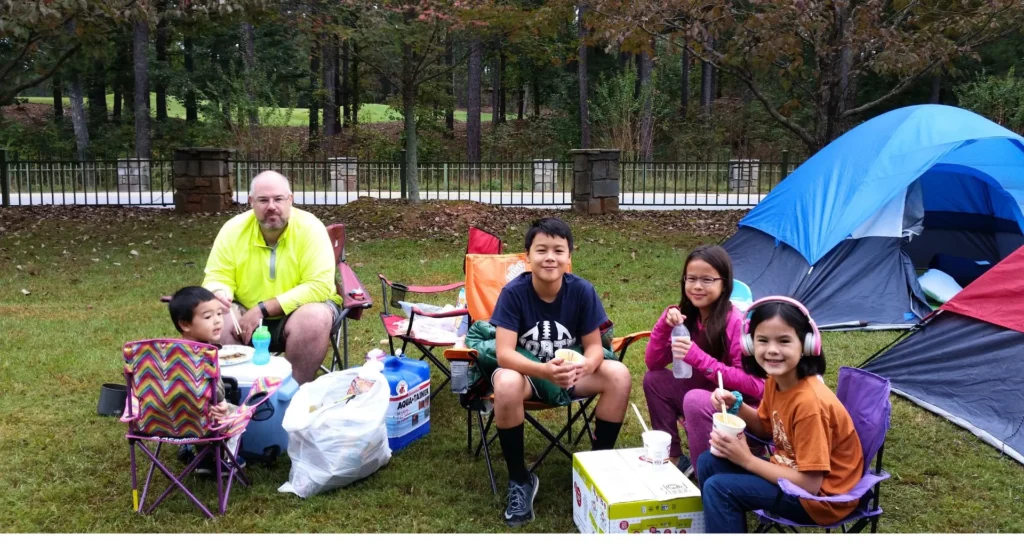
Here are some things we found that actually matter when picking a family-friendly site:
- Flat, level ground makes tent setup easier and keeps you from rolling downhill all night.
- Shade is important, especially in summer. Shade makes your tent bearable and protects the kids.
- Proximity to bathrooms does matter. We like to keep a couple of sites away. We like to be able to walk to the restrooms in no more than two minutes. Right next to the restrooms means noises, smells, and foot traffic.
- Distance from water hazards is important. The younger your kids, the more important this is. Lakes and streams are fun to play in, but the closer you are the more supervision the little ones need.
- Nearby open space is a definite plus. Kids need room to run, throw frisbees, ride bikes or let loose.
- Privacy is a necessity. Bushes, trees, or space between sites means fewer encounters with neighbors and fewer eyeballs following your every move. It also means less chances for your kids to disturb others.
- Enough space is important. You need space for tents, chairs, the fire ring, and a play area. The more gear you have, the more space you need.
Tip: If you plan to take our advice and book close to your house, you can check out the site before you book. Most campsites will let you drive through and look before you book the site. Just tell the office you are planning to visit for a weekend and want to drive through and look at the sites. I have only had one site refuse to let me do this. They would only let guests with reservations enter the campground. However, we were able to park close and take the hiking trail into the campground and explore it. Doing this showed us exactly the site we wanted to book.
Campground Features Can Make or Break Your Trip
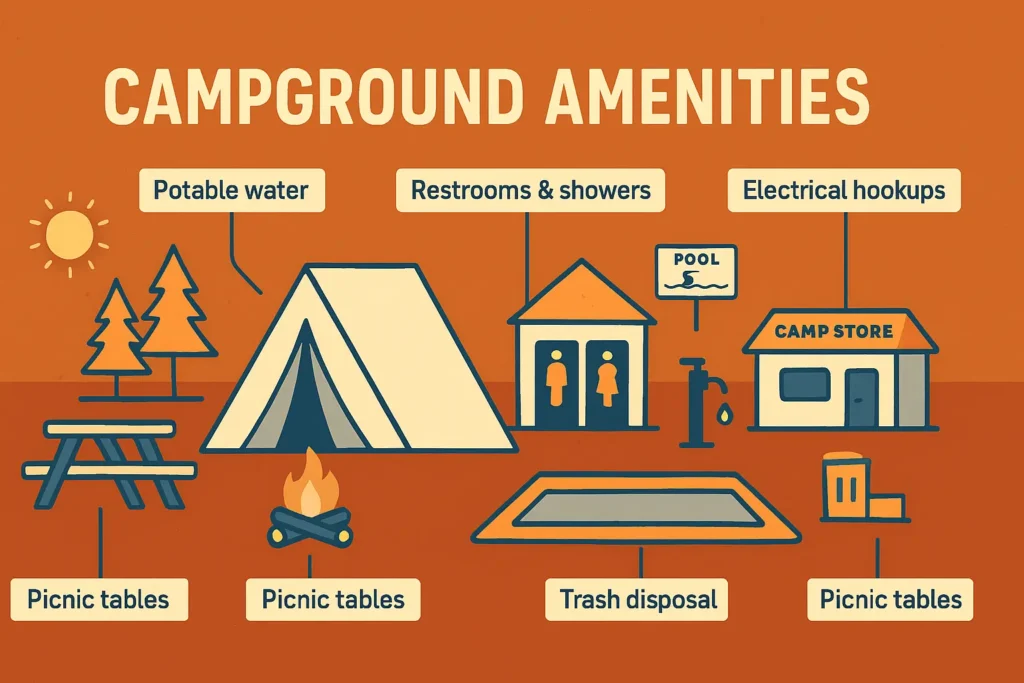
Let’s be real. Bathrooms and showers don’t sound exciting, but they matter. A lot. More than you think they will. Especially when you’ve got toddlers, diapers, or kids covered in dirt or wearing their s’more.
Check for these basics:
- Clean restrooms are important. We generally look for flush toilets.
- Hot showers are important if you plan to stay longer than one night. Everyone will need a shower. You will feel 1000% better when you are able to take a hot shower after a long day of rangling kids.
- Potable (drinkable) water doesn’t have to be at your site, but you need a source close to you for drinking and cleaning up.
- Electrical hookups are nice but not necessary. You can bring battery banks to charge devices.
- Trash bins are necessary to keep critters away from your site. At a minimum, you need a campground that picks up the trash at your site every morning.
- Picnic tables and fire rings should be at every campsite. If they don’t have these, don’t book the site.
- Paths or flat surfaces are nice to have. You need an area to play and paths are great for walks with a stroller.
We stayed at a site with no trash bins and did not realize this until we got there. We spent the weekend keeping trash in the car and then hauling it back home. It was not one of my finest moments.
Tip: If the listing mentions the trash cans are bear safe, be ready to follow wildlife safety rules. You will probably never see a bear, but it means they have been seen in the area before. Put your trash in the bins and don’t leave it laying around your site. Raccoons can flip your cooler, rip apart a trash bag, and host a midnight buffet. And they will never have the decency to clean up after themselves.
Your Kids will Determine Your Campsite
If you haven’t figured this out already, I’m going to let you in on a secret. Every kid is different. This means every camping trip will be different. What works for my family might be a total mess for yours.
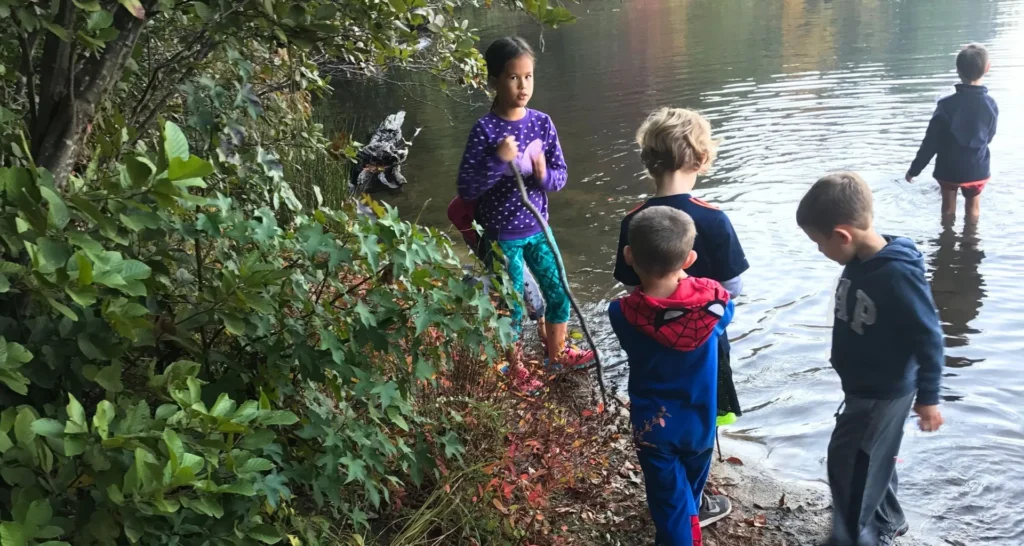
That’s why picking the right campsite based on your kids’ ages and personalities is one of the most overlooked, but most important parts of the whole experience.
When our youngest was three, our main priority was being close to the restroom. My son had a sixth sense for needing to go exactly when we started cooking dinner.
Our oldest wants enough space to be by himself and chill in a hammock. This meant we needed sites with trees close enough together to hang a hammock.
Choosing a campsite is not so much about finding “the best site.” It’s more finding the campsite that is the best fit for your family right now.
- Toddlers
- Pick sites that are open and flat space with minimal hazards.
- Stay away from sites near water, roads, or steep hills.
- Look for sites with plenty of shade, room for them to wobble around safely, and short restroom runs.
- Elementary-age kids
- Kids this age need places to play. Look for playgrounds, trails, bike loops, and open spaces.
- Sites near other families can be great. Your kids can make instant friends.
- Your site can be a short walk from restrooms, but away from high traffic main roads.
- Teenagers
- Look for more large, private sites with room for everyone to spread out.
- Lakes, fishing, or hiking trails nearby give them options to swim, bike, hike, kayak, etc.
- Find a site with enough room for a second tent for them or enough space to set up a hammock. They get independence and don’t feel like a kid, but they are still close enough that you know they are safe.
Tip: Don’t assume your kids will like what you liked as a kid. I made this mistake when we got started. Let them help choose the site and you will find out what they are looking for. If they feel part of the decision, they’re more invested in the trip.
Tip: Don’t assume your kids will like what you liked as a kid. I made this mistake when we got started. Let them help choose the site and you will find out what they are looking for. If they feel part of the decision, they’re more invested in the trip.
How Do You Know You’re Getting What You’re Booking
Please don’t trust every glossy campground photo. Many of these are stock photos of generic campsites or they are from years ago when the site was first built. I’ve booked sites advertised as shady and quiet that turned out to be in the full sun next to a dumpster.
Lesson learned. Now each time I book at a new campground, I turn it into a mini research project. I suggest you do the same simply because it will save you from big headaches later.
Here are some ways I do more research:
- Using the campground map is the best way to start. Most campground websites will have a map. Use this to see the overall layout of the campground. Look at different sites and their location relative to restrooms, water, roads, playgrounds, pools, lakes, etc.
- Read real reviews from real families on sites like Google, TripAdvisor, The Dyrt, and Campendium. These are golden. These are real campers who visited the campground and are posting the good, the bad, and the ugly about their stays. These sites will let you filter for reviews for keywords like “kids,” “clean,” or “restroom.”
- Watching walkthroughs on YouTube will show you exactly what the campsite looks like. If you have never searched for this on YouTube, be prepared to be amazed. Many campers post reviews of their site and the entire campground. This way you will know if the campground will work for your family. You will know exactly what to expect when you get there.
- Use AllTrails or CampsitePhotos.com to see real photos. CampsitePhotos.com often have real images of the site you’re thinking about reserving from other families who stayed at the same site.
Tip: Search for “[Campground name] best tent sites” or “sites to avoid at [Campground]” and you’ll find helpful threads on Reddit, blogs, or forums from people who’ve been there. This will show you exactly what to expect and even better tell you campgrounds or campsites to avoid.
Take a couple of hours before you book to do this research and you’ll confident about your decision instead of crossing your fingers and hoping for the best.
We turn this into a family project. We list a few possible choices for campgrounds and then turn the kids loose to research. We have a family meeting and discuss different sites and what we like or don’t like about each site. We are able to make a well informed decision about what site to book.
When we started doing this, we discovered it created a bunch of excitement about our upcoming trip and was a super fun family activity.
What If the Perfect Site Isn’t Available?
Spoiler alert: many times, it won’t be. And that’s okay.
You really have three choices in this situation.
- Change the date of your trip to when the site is available.
- Wait on a last minute cancellation.
- Decide to go to your second or third choice.
We have had some pretty awesome trips grabbing a last-minute cancellation or exploring our second-choice campground. The key is to be flexible, nothing is set in stone until you secure a reservation. And we have had our site sell out from under us while we were going through the reservation online.
Being willing to adapt is a great skill to learn and will help you have more fun and less stress.
Here are some ways we have pivoted in the past:
- Try camping midweek because weekends always fill up first and fast. Tuesdays – Thursdays are less busy. Midweek trips will let you book one of the more popular sites. A bonus is the campgrounds are less busy so you end up with fewer neighbors. We went on a midweek trip in November once and we had the entire tent area to ourselves. It was glorious not having to worry about bothering our neighbors or having them bother us.
- Look at lesser-known campgrounds nearby since these are usually not as busy. State parks 30 minutes from a national park often have more availability and similar scenery. Likewise, small, private campgrounds are less advertised and are only known to locals. This means less vacationers find these campgrounds.
- Call the ranger station and ask them. Seriously. They often know about cancellations, overflow sites, or local campgrounds that didn’t show up in your online search.
- Try first-come, first-served sites at some campgrounds. Show up around lunchtime. Most checkouts are at 12. You may be able to snag a great spot from someone checking out early. Some campgrounds hold a couple of sites in reserve just for the first-come first-serve. There is no guarantee you will get a site, so pack light and have a back up plan if no site is available.
Tip: Have a backup list of campsites or campgrounds available. We usually list several sites in each campground we like. When we start making reservations we work down our list until we get a site. If you go the first-come first-serve route, have a back up plan of something else to do. Let the kids know what you are going to do if there is no site. We have gotten last minute sites at Stone Mountain several times. But there have been times when no site was available. When this happens, we enjoy the park for the day and then head back home.
Booking Tips for Popular Campgrounds
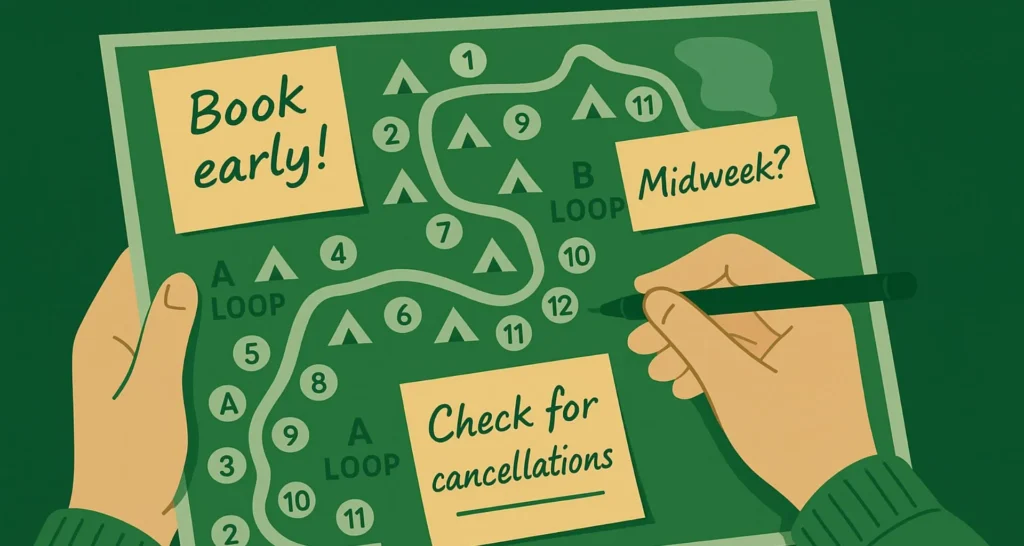
When you try to book a site at a popular campground, it can feel like a race. There are families online waiting for the minute the reservations open. You have to be type fast to succeed.
I highly encourage you to try to get a campsite at a place like this. They are in high demand for a reason and you will really enjoy your trip.
But, don’t just hope it works out. Have a back up plan.
Here’s how to give yourself the best shot of getting that prime site.
- Know the booking window. Many parks open 6 months in advance to the minute. Know exactly when the reservation window opens and be at your computer with everything ready to go.
- Set a reminder. Circle it on your calendar or set an alarm on your phone. Do whatever it takes to remember. The most popular sites vanish in seconds.
- Create an account early. Most reservation websites require that you have an account. Set this up well before your window opens. Get your payment information saved in advance. Two popular sites are ReserveAmerica or Recreation.gov. Set up an account now and be prepared.
- Use tools like Campnab or Campflare. You can set Campnab and Campflare up to send you a notification when a site becomes available or when a cancellation pops up.
- Check back often. I can’t repeat this enough. People cancel campsites all the time. I have booked multiple campsites for the same weekend before simply because we could not decide where to go. We will cancel them a few days before the trip. If there is not a way to set up an alert to tell you about cancellations, check the campground website at least once a day.
We once were able to get a prime spot during the July 4th weekend on a lake when the campground had been fully booked for months. It was a spot we had been trying to get for a couple of years. Simply because I happened to check the site at 9 PM on Thursday.
Someone had canceled. It was total luck but also I was persistent. We had not planned to go camping that weekend, but our other plans fell through. We decided to see if any campground had cancellations. It was two weeks of searching several times a day for cancellations, but in the end it paid off and we had a great time.
Tip: You can get so involved in trying to find a campsite that you get burned out. Avoid this by relaxing a bit. Change the way you’re thinking about this. Treat it like fishing. Cast a few lines by setting alerts or trying multiple dates. Eventually, you’ll catch something worth keeping.
The Right Site = The Right Start
I know some of this sounds like it is stressful. I can take a big weight off your shoulders. For your first trip, you will have fun no matter where you end up. It will all be so new to your family, you will not know what you don’t know.
Picking the right campsite doesn’t have to be stressful. But it requires some thoughtful planning.
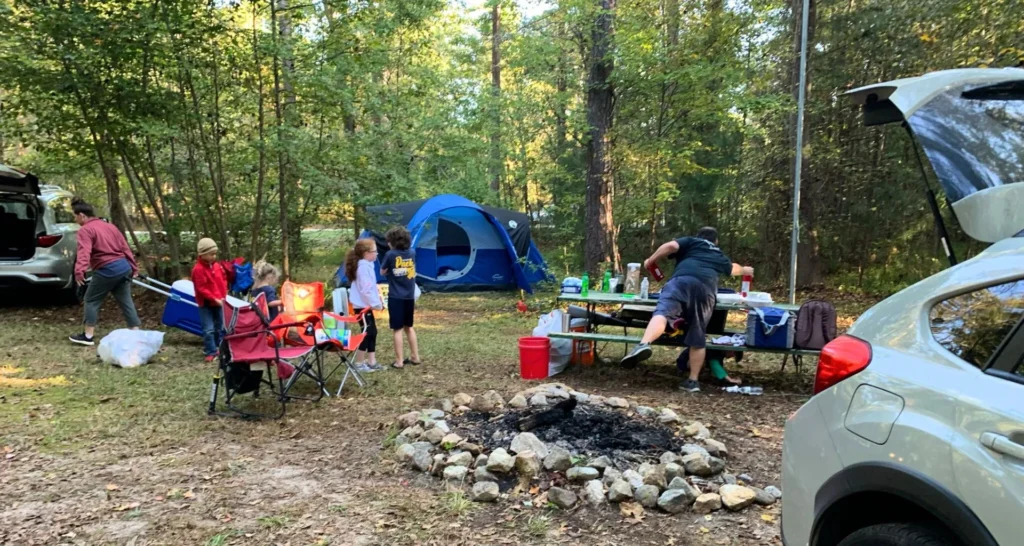
When you consider your family’s needs, your kids’ personalities, and your comfort level with the outdoors, you’ll end up on a site that works for you.
It might not be glamorous. It might not have a lake view. But it’ll be right for you and that makes all the difference in the world.
Remember, camping isn’t about perfection. Even after years of doing this, it is never perfect. It’s about showing your kids the real world, the one without screens. It’s about figuring things out together and finding happiness in the small wins. It’s about a quiet cup of coffee in the morning, a good night’s sleep in the tent, and watching your kid learn how to safely start a fire.
Start small so it feels manageable to you. Don’t try to do too much on your first trip. Get a base down. Then build on the small wins. Pretty soon, you’ll be the expert helping other first timers find success.

